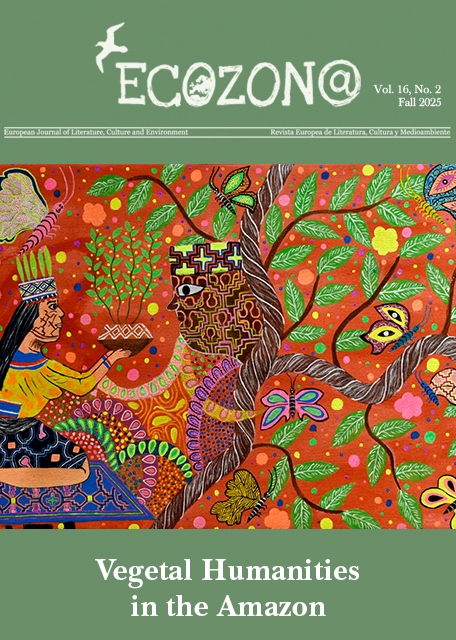“The Trees Got Their Own Ways to Hurt Us”: Entangled Bodies and Fragile Flesh in M.R. Carey’s "The Book of Koli" (2020)
DOI :
https://doi.org/10.37536/ECOZONA.2024.15.1.5201Mots-clés :
plants, flesh, speculative fiction, indistinctionRésumé
There is a post-apocalyptic England teeming with violent plants, where one break in the clouds could wake the trees around you, condemning you to become sustenance for thirsty roots. This is the speculative future of M.R. Carey’s speculative young adult novel, The Book of Koli, where humans struggle to adapt to their new role in this speculative future and plants pose an ever-growing threat. In this article, I analyse how The Book of Koli engages with, what I term, “plant flesh,” through the analogous transformations of humans and plants. Plant flesh is a development of Michael Marder’s “grafts,” where he suggests that grafts are an expression of proliferation for both plants and flesh. With grafts, Marder illustrates the vegetality of flesh; with plant flesh, I illustrate both the vegetality of flesh and the fleshiness of the vegetal. Plant flesh, then, becomes a term of indistinction (as per Matthew Calarco), where, through plant flesh, we can begin to trace the ways that humans and animals are like plants. In The Book of Koli’s young adult context, plant flesh’s indistinction captures the shared and necessary – but oftentimes violent – transformation of flesh, as teen protagonist, Koli, transitions into adolescence alongside genetically modified plants and their evolution into speculative monstrosities. Through theoretical discussions and close readings, I argue that explorations of plant flesh in The Book of Koli serve to demonstrate both the shared, violent transformations of plant and human flesh and the indistinction that such transformations encourage between the adolescent Koli and the ever-evolving plants. The Book of Koli’s speculative young adult journey, then, with its botanical threats and adolescent transformations, makes apparent the indistinct zones that can emerge, when we tend to the entangled bodies and fragile flesh of both plants and humans.
Téléchargements
Téléchargements
Publié-e
Numéro
Rubrique
Licence
Authors who publish with this journal agree to the following terms:
a) Authors retain copyright and grant the journal right of first publication with the work simultaneously licensed under a Creative Commons Attribution License that allows others to share the work with an acknowledgement of the work's authorship and initial publication in this journal (CC BY-NC for articles and CC BY-NC-ND for creative work, unless author requests otherwise.
b) Authors are able to enter into separate, additional contractual arrangements for the non-exclusive distribution of the journal's published version of the work (e.g., post it to an institutional repository or publish it in a book), with an acknowledgement of its initial publication in this journal.
c) Authors are permitted and encouraged to post their work online (e.g., in institutional repositories or on their website) prior to and during the submission process, as it can lead to productive exchanges, as well as earlier and greater citation of published work (See The Effect of Open Access).










